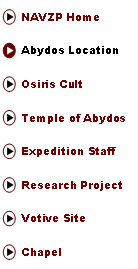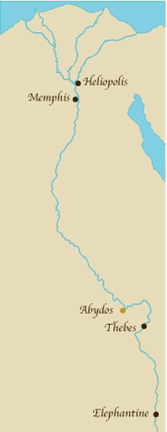




|
Menu |
|
Geography of Abydos
The site of Abydos is located at the edge of the low desert on the west side of the Nile, approximately 150 kilometers north of Luxor in southern Egypt. The floodplain in this part of Egypt is relatively broad, spanning approximately 14 kilometers from the west bank of the river to the high desert cliffs. A distance of more than 11 kilometers now separates the site of Abydos from the Nile. This distance would probably have been somewhat less during the Dynastic period because the Nile has shifted gradually eastward over the last two millennia, particularly in the region of Middle Egypt. In ancient times, the site would have been linked with the Nile by a canal which was part of a larger irrigation and transportation system that extended through the cultivated area in the broad floodplain characteristic of the region. The Osiris Temple Enclosure is less than one kilometer west of the modern canal of Al-Kisrah, which closely follows the line of the cultivation and may represent the route of part of the ancient canal system that once linked Abydos to the Nile.
|


|
Abydos is a large and complex site that preserves evidence of habitation and utilization from the Paleolithic period to modern times. Greater Abydos spans an area of approximately 3 square kilometers. The ancient monuments at Abydos are oriented according to a relative directional system based upon the direction of the Nile at this location, rather than on the cardinal points. Within this system, "local" North is roughly equivalent to true Northwest. The local northern part of the site is adjacent to the modern villages of Arabah el-Madfuna and Deir es-Sitt Damiana, while the local southern part of the site extends to the modern village of el-Ghabbat. The famous temple of Seti I, one of the best-preserved and most beautifully decorated ancient Egyptian structures, is situated in Arabah. |
|
Home | Location | Osiris Cult | Temple | Staff | Research | Site | Votive Chapel |


|
North Abydos Votive Zone Project |
|
Copyright © 2006 Department of Near & Middle Eastern Civilizations, University of Toronto. All rights reserved. |